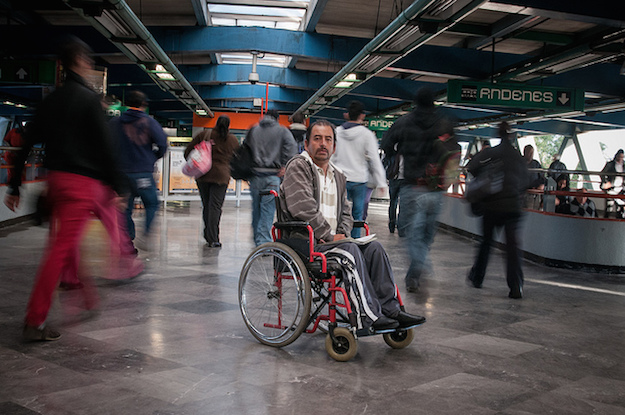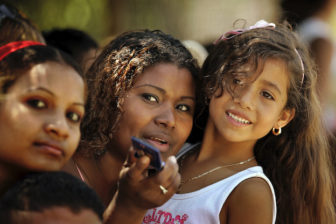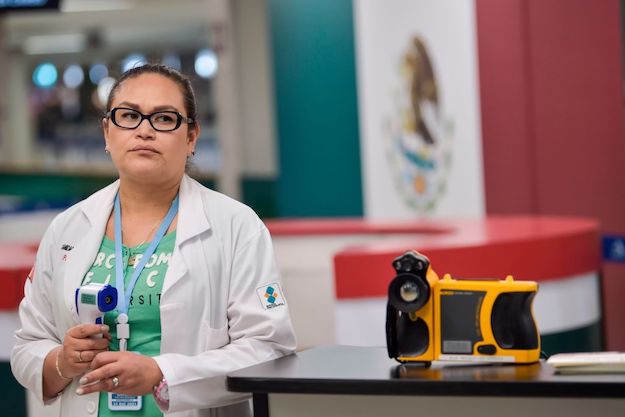The senator from Durango looks bemused. It’s the afternoon of Oct. 18, and Yolanda de la Torre, seated and wearing an electric pink suit jacket with navy slacks, is being carried up the switchback stone staircase of Mexico City’s Palacio de Minería. The 250-year-old college building, now run by the national university’s engineering department, has only one elevator. The senator’s wheelchair doesn’t fit.
“Can you imagine?” Katia D’Artigues, a journalist and disabled rights advocate who was at the Palacio that day, told AQ. “Nobody made a big deal about it, though of course they should have.”
Perhaps the scene would have drawn more attention had it not been so commonplace. In much of Mexico’s mammoth capital city, crumbling sidewalks and a lack of elevators, ramps and other trappings of accessibility mean that many of its estimated 500,000 people with disabilities must rely on friends, family or strangers to get around.
Or, as in de la Torre’s case, up. The senator was at the Palacio that afternoon because she is a member of the assembly tasked with drafting Mexico City’s new constitution, which will come into force next year. D’Artigues, who, like de la Torre, sits on the assembly’s “general principles committee,” believes that the constitution can serve as the foundation for improving accessibility in the city – as well as the civic inclusion of people with disabilities more generally.
“It can and it must,” said D’Artigues, who told AQ that she wants accessibility to be included as a basic principle of the document, which would make it an obligatory consideration in subsequent legislation and project planning. “The city’s governing bodies must take concrete steps to guarantee the free circulation of people with disabilities and their access to public transportation, to justice … and to education. To guarantee all of their rights.”
As it happens, though, Mexico already has legislation and international agreements in place that should guarantee those rights. The country is a signatory to the U.N.’s 2007 Convention on Rights for Persons with Disabilities, and in 2011 then-President Felipe Calderón signed legislation to ensure the inclusion and non-discrimination of people with disabilities.
Both of those documents include guarantees of accessibility, but the language is vague and goes mostly unenforced. In Mexico, just around 40 percent of private businesses – those with 50 employees or more – are required to be wheelchair accessible (the regulation also applies to businesses with disabled employees). Even then, how to provide that access is left largely to businesses themselves, often leading to accessibility in name only: ramps that are too steep to be functional or wheelchair-accessible entryways buried deep in underground parking lots are commonplace.
I met with Santiago Velázquez, the founder and president of Vida Independiente México, at a restaurant tucked inside Mexico City’s Benito Juárez International Airport. Velázquez’s organization trains people with disabilities to navigate the city on their own, regardless of physical obstacles; more than 75 men and women who went through his program now work at the airport through a security contractor. He said that changing attitudes toward people with disabilities is a shared responsibility.
“We haven’t gotten very far in creating laws with teeth,” Velázquez said. “That’s why we need to work directly with legislators, to build a different kind of understanding … so that our proposals are about showing opportunity rather than making demands.” Vida Independiente’s slogan is “Without independence, there will be no inclusion.”
Indeed, though perhaps lagging in accessibility, Mexico has made great strides in terms of labor inclusion and non-discrimination. Government programs and tax incentives have played a big part in incorporating around 2.5 million of Mexico’s estimated 7.5 million people with disabilities into the work force.
Nor is the country lacking the regulatory bodies needed to ensure disabled rights and improve accessibility. Funding for programs for people with disabilities is split primarily between the ministries of health and of social development, through the National Council for Equality and Inclusion of People with Disabilities (CONADIS). But neither CONADIS nor COPRED, which monitors discrimination and social inclusion in Mexico City, regularly cite or sanction businesses or public agencies that are in violation of Mexico’s international and constitutional commitments. Mexico’s National Center for Human Rights likewise has a mandate to work with policymakers to improve inclusion and accessibility for people with disabilities, but it serves only an advisory role.
Budget allocations that could enable more active enforcement of regulatory requirements are hard to come by in today’s economic environment. The government’s budget proposal for 2017, approved by Congress in October, called for $12.83 billion in spending cuts. A fund designated in 2011 for states to spend money on making public transportation more accessible – which in 2016 totaled 600 million pesos (about $32 million) – was zeroed out of next year’s proposal. Though states haven’t always taken full advantage of the money available to them in years past, Mexico City did spend 70 percent of the 38.3 million pesos apportioned to it in 2015. Still, just 49 of the city’s 115 metro stations even have elevators.
To be sure, Mexico is not the only place where protections for people with disabilities could be strengthened; just 51 of New York City’s more than 400 subway stations are considered fully accessible. Many countries in Latin America are only now taking steps to ensure that people with disabilities are not limited in civic life. In the U.S., the Americans with Disabilities Act wasn’t passed until 1990, and was substantially amended as recently as 2008.
In the end, though, the biggest obstacle to including people with disabilities in public life in Mexico, as elsewhere, may not be economic or political.
“Breaking down architectural barriers is easy,” Luis Quintana, the founder of Todo Accesible, an advocacy group, told AQ. “The cultural barriers, that’s the hard part.”
According to Quintana, there are not enough social pressures on people who block wheelchair access ramps, take disabled parking spaces, or otherwise fail to consider people with disabilities. He said it goes hand in hand with the stigmatization and dehumanization that many people with disabilities feel they have to fight against. A recent trend toward social media shaming of bad behavior in Mexico may go some way in forcing an improvement, but Quintana believes that the impetus for change will come first from people with disabilities themselves.
“We can’t just sit there with our hands out. We have to show people that it is in their interest for our community to be included,” Quintana said. “People need to understand that just because someone is in a wheelchair doesn’t mean they don’t want to go dance, or because they are blind that doesn’t mean they don’t want to go to the movies.”
Perhaps the effort to change perceptions can start with some general principles. On Dec. 10, the assembly drafting Mexico City’s new constitution approved its bill of rights, which included support for people with disabilities and their families. It’s not the end of the road, but it’s a start.
—
Russell is an editor for AQ









